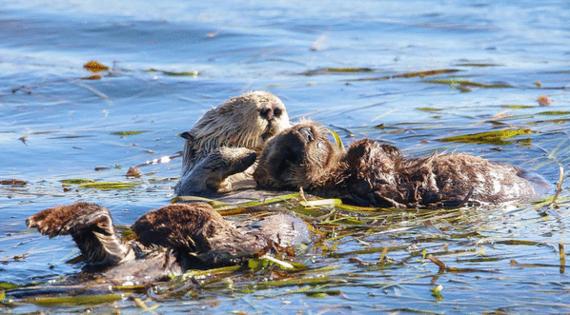
SAN LUIS OBISPO, Calif. — Sea Otter Savvy monitors the animals in the Morro Bay Harbor, tracking their behavior and watching how they react to their environment. Sea otters remain a threatened species in California.
Despite recent efforts by sea urchin harvesters to reduce protections for southern sea otters under the Endangered Species Act, the species is still at risk, federal officials say.
The fuzzy marine mammals, often seen swimming around San Luis Obispo County coastal areas such as Morro Bay and Avila Beach, will remain classified as “threatened,” according to a species status assessment report published on Sept. 19 by the U.S. Fish and Wildlife Service.
“We’re very pleased with the decision,” said Gena Bentall, director and senior scientist for Central Coast-based nonprofit organization Sea Otter Savvy. “We’re keenly aware of the threats that the southern sea otter population faces in its current status, so I’m certainly pleased, but not surprised.”
Southern sea otters used to populate the coast from Oregon to Baja California in Mexico. However, the maritime fur trade during the 18th and 19th centuries decimated the species.
Now, fewer than 3,000 otters, according to the most recent count in 2019, occupy the California coast from around Pigeon Point near San Jose to Gaviota State Beach in Santa Barbara County.
The current population likely all descended from about 50 sea otters that survived the fur trade near Bixby Creek in Monterey County, according to Fish and Wildlife.
Sea Otter Savvy staff and volunteers counted roughly 50 otters calling the Morro Bay estuary home in recent weeks, according to Bentall.
Fish and Wildlife has estimated California could host more than 17,000 southern sea otters, provided there is enough food for the creatures.
The southern sea otter was listed as threatened under the federal Endangered Species Act in 1977.
Although there have been dedicated efforts in the decades since to restore the species’ population, those efforts have been met with several challenges.
Threats from diseases, parasites and shark bites hinder southern sea otters from repopulating to historical numbers, especially along the Central Coast, according to the Fish and Wildlife assessment.
Petition to delist southern sea otters filed by sea urchin harvesters
In their March 2021 petition to delist the southern sea otter from the federal Endangered Species Act, the California Sea Urchin Commission and Commercial Fishermen of Santa Barbara argued that disease and shark predation “do not threaten the sea otter with extinction in the foreseeable future but are, at most, natural checks on the species’ continued expansion.”
The growth of the southern sea otter population along the Central Coast has created issues for the sea urchin harvesters, the petition added.
“Sea otters voraciously consume sea urchins, depleting the stock and frustrating sustainable harvest efforts,” the petition said. “Regulations resulting from the sea otter’s listing also interfere with sustainable harvest (of sea urchins) by exposing urchin divers to the threat of significant criminal and civil penalties should their activities disturb an otter.”
The petitioners noted that, while they want the southern sea otter population to recover, they hope that Fish and Wildlife will implement legal protections for fishermen to reduce their risk of liability for disturbing otters while harvesting sea urchins.
Tailoring disturbance regulations designed to protect the southern sea otter would “have conservation benefits by creating the goodwill needed for further recovery action,” the petition said.
Shark bites one of largest contributors to sea otter deaths
The number of southern sea otters bitten by great white sharks appears to have increased in the past two to three decades, leading to more of the marine mammals dying, according to the Fish and Wildlife assessment.
White sharks don’t eat sea otters, said Mike Harris, a senior environmental scientist with the California Department of Fish and Wildlife.
Rather, they make “exploratory bites” that can be harmful enough to be deadly, Harris said.
Roughly half of the sea otter carcasses found along the Central Coast exhibit shark bites, Harris added.
Shark bites have likely contributed to the southern sea otter’s inability to repopulate its historical range, according to the assessment.
White sharks and sea otters have likely always coexisted, Harris noted.
“But we’re seeing a noticeable shift in white shark habitat that may be a result of climate change and warming oceans,” he said. “Their habitats may be overlapping more now than ever.”
Warming ocean waters may be pushing white shark habitat north.

Excess atmospheric heat is mostly absorbed by the ocean, according to the National Oceanic and Atmospheric Administration.
As more greenhouse gasses are emitted from human activities, heat radiated from the Earth’s surface is trapped in the atmosphere. That has caused the upper levels of the ocean to heat up significantly over the past few decades, NOAA says.
Harris said he’s seen a definite increase in the number of sea otters killed by white shark bites.
“It’s one source of mortality we know we’re not going to be able to manage,” he said. “So, it puts more emphasis on our ability to manage the protozoal infections we’re seeing come from our waterways.”
Polluted waterways put sea otters at risk
Sea otters have been killed by infections that stem from polluted streams and creeks that flow into their habitat.
For example, three sea otters — one in San Simeon in 2020 and two in Cayucos in 2022 — were found to have died from an unusual parasite shed from cat feces called Toxoplasma gondii, according to Fish and Wildlife.
Sarcocystis neurona, a parasite shed from the feces of non-native Virginia opossums, has also historically killed sea otters along the Central Coast, according to Harris.
Sea otters are susceptible to pollutants in the water particularly because they live near the shoreline where stormwater carrying toxins and parasites rushes out.
Additionally, the otters eat a large amount of filter-feeders, such as oysters, mussels and clams. Toxins and parasites can concentrate in the marine invertebrates and lead to infection in the sea otters.
How you can help southern sea otters survive
Beyond ensuring waterways are kept as clean as possible by restoring natural vegetation and eliminating invasive species, there is one simple action humans can take to help southern sea otters recover: keep a safe distance.
Sea otters live “paycheck to paycheck” in terms of the amount of energy they use, Bentall said.
Their survival is based on whether or not they’re able to consume enough food each day, she added.
So when humans recreating in the ocean — such as on kayaks, paddleboards or boats — get too close to otters, the wild animals must use some of their energy to get away and find safety, Bentall said.
Sea Otter Savvy advises people to stay at least five kayak lengths, or roughly 50 feet, away from sea otters at all times. If the sea otters are looking at you while you’re observing them, you’re likely too close, Bentall said.
“It’s really hard sometimes just watching the news every day ... (and wondering) what impact you can make positively in the world,” she said. “Giving wildlife wherever you are extra space to do what they need to do to survive is a powerful act.”
_____


.png)

